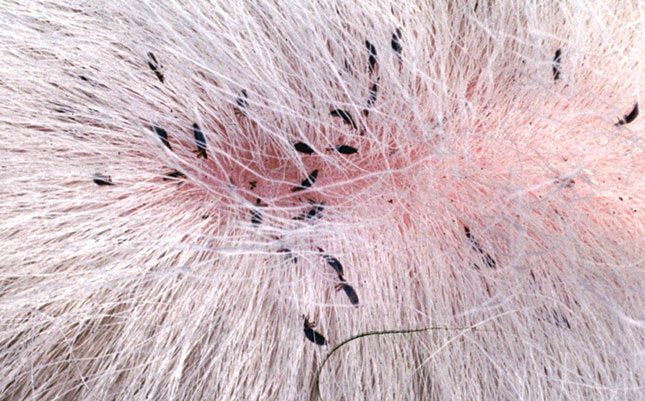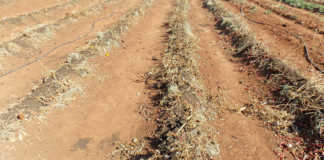
Photo: Wikimedia Commons | Alan R Walker
Small stock with a heavy lice burden will continually scratch themselves, use their mouths to pull at their wool or mohair, or rub against walls, poles, trees and other objects. Wool sheep are particularly prone to this problem, especially when the wool is long.
When seeing this behaviour, many farmers mistakenly think it is due to sheep scab or itch mites. They then apply an injectable antiparasitic remedy, but this has little or no effect. Dipping is the only really effective way to control lice.
How to dip your sheep or goats
There are three ways of dipping livestock. Whichever way you choose, it must be carried out correctly, or you will not solve the lice problem.
- Spray and plunge dipping
This method is best for meat goats and cattle. Follow up a week later to destroy recently hatched parasite eggs.
You can use this methol with some success on sheep with short wool, but it’s not ideal, as the dip solution may not soak right down to the skin where the lice have attached themselves.
It is even more difficult, obviously, to dip sheep with long wool in this way. In addition, you should never dip sheep (a) eight weeks before shearing, because the solution may affect wool texture and quality, or (b) four weeks after shearing, as shearing wounds can become infected with the poison from the dip.
- Pour-on dip
You can use this method on animals with short or long wool/hair.
– Meat (short-haired) goats and cattle: pour the dip along the backline from between the ears to the tail. Follow up a week later to kill recently hatched lice eggs (unless the dip is a long-acting one and the first application lasts for several weeks).
– Sheep and mohair goats with long wool/hair: place 1mℓ of dip under each ‘armpit’ and under the tail (thus using 5mℓ per animal).
With pour-on dips, there is no waiting period for wool sheep. You can also dip pregnant livestock safely in this manner (unless the instructions say otherwise).
Signs of lice infestation
- Cattle
The animals will be agitated and restless, and look for something to rub against. Eventually, they will show clear signs of patchy hair loss, leaving white and dry-looking skin.
The body condition of such animals may deteriorate, as they spend more time trying to rub the itch away than eating.
Sometimes, the rubbing can be so vigorous that it causes open sores, which may lead to more serious opportunistic infections. Obviously, animals like this will lose their value in the marketplace.
- Meat sheep and goats
The signs are similar to those in cattle. Closer to the skin, however, there may be dark, dirt-like deposits clinging to the hair and wool. Where hair or wool is missing, the skin may be pink in colour.
- Angora goats
Rubbing and biting at the mohair is a sign of lice infestation. Continual rubbing may cause large tufts of hair to dislodge and be lost. Where hair is missing, the skin may be pink, and dirty deposits are often clearly visible.
- Wool sheep
Infected animals may pull entire clumps of wool out, and excessive rubbing will often remove large sections of wool along the sides and neck of the animal. The wool may suffer breaks (weakened or broken wool strands), which drastically affects its value.
Longer wool may eventually turn yellowish and become matted and hard to the touch. Where wool is missing, the skin may be pink.
More tips
Lice have a very short reproduction cycle and can increase their numbers dramatically in weeks. Monitor your animals closely for signs of infestation.
Treat animals in a proactive rather than a reactive manner, and carry out follow-up treatments as suggested to break the life cycle of the lice.
Stubborn infestations may even require a third treatment. Don’t wait too long before doing follow-up treatments; seven days is recommended.
Follow the manufacturer’s instructions. If you fail to do so, the treatment may be either ineffective or toxic. As far as possible, avoid environmental and water contamination when using dips and similar treatments.
Shane Brody is involved in an outreach programme aimed at transferring skills to communal farmers.










